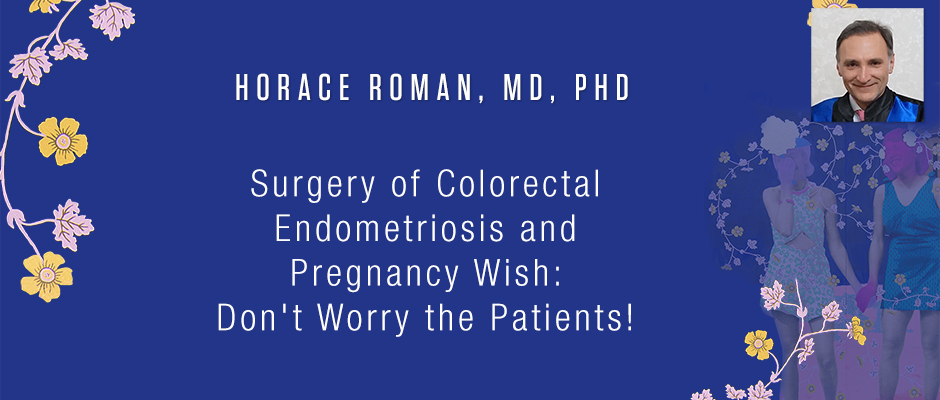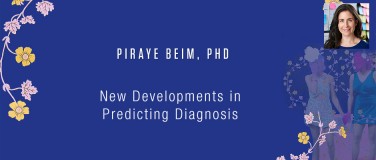Horace Roman, MD, PhD - Surgery of Colorectal Endometriosis and Pregnancy Wish: Don't Worry the Patients!
Patient Awareness Day 2019: HEALTHY MIND & HAPPY PELVIS
Living Your Best Life With Endo
March 10, 2019 (8am - 5pm)
Einhorn Auditorium, Lenox Hill Hospital, New York City
https://www.endofound.org/patientday/2019
Ladies and gentlemen, Mr. Chairman, dear David, Tom and Dan, I am very grateful to be involved in your meeting and you have to know that I will spend two days here and two days in the plane but honestly, it is totally justified because I was involved in an excellent meeting and I think the best I have seen for hears. I am very pleased to speak to you about a very fashionable topic, the best strategy of management in women with deep severe endometriosis involving the colon and the rectum and pregnancy wish. The message is don´t worry the patients. Why colorectal endometriosis? Because colorectal endometriosis is the most frequent very severe localization of the disease and there are a myriad of papers about this localization, so we can conclude on a strategy.
Let´s say that we are somewhere in France or in the United States and you have a very typical classical situation where a young woman, thirty years old, stops the pill to get pregnant. And she has always had dysmenorrhea but not very severe. But once the pill was stopped she becomes very painful and three or four months after the endometriosis is revealed and it is a big one. A colorectal endometriosis. She´s referred to a doctor and the doctor asks her (this is the question not to ask) what is your priority, relieving pain or getting pregnant? The patient will answer getting pregnant. And the doctor said well, in this case, you need first one or several IVFs and then we will see.
This question should never be asked because it suggests that the two goals, relieving pain and reaching pregnant, cannot be accomplished in the same time. This is completely wrong. Once someone tells you you have endometriosis you think immediately about the infertility, so the pregnancy wish becomes the first objective. She´ll undergo IVF but is she still infertile? She has just attempted for four months to get pregnant. My colleague physician who asked the question has based his conviction on guidelines and the guidelines are very similar between several countries because we have no randomized trial comparing the surgery to IVF. Guidelines say that there is no strong recommendation to do the surgery before the IVF because nobody demonstrated that the results of IVF would be improved. This is the conclusion but I think that this conclusion is misunderstood because asymptomatic patients with endometriosis are not very numerous. If you ask the good questions, you find them symptomatic.
When you speak about symptoms, everybody thinks about pain, dysmenorrhea, chronic pelvic pain. But there are other symptoms much more embarrassing, much more severe than simply dysmenorrhea or chronic pain. Dibdesparonia is an infertility risk because you cannot have sexual intercourse. You cannot have mature pregnancy. But it is frequently overlooked by physicians. Dysuria for me is the worst symptom a patient may present because it shows that the splanchnic nerves [inaudible 00:05:09] to the bladder have already been injured. It is a huge risk of definitive self catheterization. Dysuria is not pain but it´s very similar symptoms.
Blotting and constipation during periods may not be painful but it´s very similar symptoms because the patient my have bowel occlusion. Every year I have to manage at least one patient with stoma due to occlusion. I used to manage several patients with sub occlusive lesions.
Silent kidney. If you have stenosis of the ureter this is not painful at all. However, the kidney will progressively disappear and it will have an effect on you. This is not painful unless an unexpected pyelonephritis justify an [inaudible 00:06:04] ultrasound and the radiologist will say this is very amazing, there is no more kidney.
[inaudible 00:06:14] or sciatic pain. They are outside the pelvis, so one may believe that it has a lumbar origin and refer the patient to kinesiotherapy or [inaudible 00:06:26]. It´s a large endometrial legion and that surgery is completely justified. Let´s say that our young patient is just painful, none of these very severe symptoms, so what she can expect depending on each strategy?
French patients now ask a lot of questions. What is my probability to be pregnant if I do this and what is my probability to be pregnant if to do this? I think that in the United States the patients are similar. We have to give her data about the probability of pregnancy following IVF and following surgery.
Fortunately we have data. For example, a patient who has colorectal endometriosis, no surgery but IVF. One of my best friends, Marcus Baluster from Paris performed a study where he estimated the probability of pregnancy in these kinds of patients. He observed that if all the patients have three cycles of IVF, pregnancy rate may rise up to 68%. However, the disease is still there and the symptoms too. What about the surgery followed or not by IVF? We have data and many data comes from my own team. The pregnancy rate may rise up to 70 or 80%. Other colleagues tried to estimate whether or not the surgery of endometriosis could improve the natural conception because you know that women with stage 4 endometriosis and colorectal disease probably have a likelihood of pregnancy less than 10%. On the basis of a systematic review an Italian team observed that the natural conception after the surgery of endometriosis may rise to 25%. There is an excess of natural conception due to the surgery.
Now let´s have a look at our studies [inaudible 00:08:41] and all the patients are recorded in a data base. We started this database in 2009 there were 3000 patients and they answer questionnaires every two years. It´s a huge database. We can estimate the probability of pregnancy, the probability not having pain, the probability of reoccurrence. I tried to understand whether or not in patients who had endometrioma, if you perform only on the endometrioma surgery or endometrioma and colorectal endometriosis, the pregnancy rate is different.
The goal of the article was to show that if you perform the treatment of endometrioma using plasma energy, a kind of ablation, the pregnancy rate is not worse than after cystectomy in the literature. I was surprised to see that performing colorectal management at the same time does not decrease the pregnancy rate. Furthermore, we observed 60% of pregnancies in this group, while in the group of Marcus Baluster with first line IVF I told you that the probability of pregnancy was 68% if all the patients have three cycles, but actually in his sample he observed 45% of pregnancies. Here we observed an actual rate of 64% of pregnancies. Then we put together the database from Paris and that from Rouen and we tried to understand that if you perform complete colorectal surgery and IVF what kind of results we can expect. Does the colorectal surgery decrease the probability of pregnancy after IVF? Not at all. After three IVF the probability of pregnancy is 78%. We observed a pregnancy rate of 60%. It was better than in his previous study where all the patients had deep endometriosis and only IVF.
Here is my last paper. It is a paper where the patients had large deep endometriosis infiltrating the rectum and they were randomized between colorectal resection and shaving or disc excision. There was a randomized trial with a very close followup (no one loves to follow up patients) and I continue to follow them up. Four to six years after the surgery I observed that the rate of pregnancy in this group is 80%. The majority of pregnancies were spontaneous conception. Even though I have a look only on patients with preoperative infertility, the patients with proven infertility because prior to surgery they tried to get pregnant for more than one year. In these patients the rate of pregnancy is 75% and the majority are natural pregnancies.
Another argument to send directly the patients to IVF is that we have no time. We have to go fast. In this group I tried to understand whether or not the patients I refer after the surgery directly to IVF for several reasons were pregnant earlier than the patients where I said you have to try to spontaneously conceive during one year because I feel it may work. I think you see in this picture that the patients with natural conception conceived earlier than the other ones because to have an idea, you have to take an appointment, you have to wait to have an appointment then you have to have an infertility assessment then you stay online to have the procedure, the first IVF maybe is not successful, you wait for another one, so it´s not very fast, the IVF in practice.
We have also two studies where the patients in the same team share one arm IVF one arm surgery. This is very interesting to estimate the actual effect of each strategy. This study comes from Sao Paolo. Paulo Bianchi is a surgeon in Sao Paolo and he published this paper ten years ago. This is not a randomized trial unfortunately because if it had been randomized the debate would have been closed. The patients could choose themselves if they want to be operated on or if they want to have an IVF. This is a confounding factor so we cannot conclude that the results are definitive. He observed that the patients who choose to have surgery and then IVF had ultimately higher pregnancy rate that the patients who kept their nodule and had IVF.
However when I looked this paper I saw that the authors took into account only the patients who had the IVF. They overlooked the spontaneous conception. I called Paulo and I said please, go to your database and look at the rate of patients who had a spontaneous pregnancy and he called me back and said yes you´re right. In the surgical arm we have 20% of patients with spontaneous conception and in the IVF arm we have 8%, 9% spontaneous conception, which made sense because the likelihood of pregnancy is rarely 0. It´s less than 10% so 9% is very logical. If you put together IVF pregnancies with natural pregnancies you have 50% in the group of surgery and 30% in the group of IVF. It´s a pity that this study was not randomized.
Then we have a look at data from Paris and Rouen put together and you observe that if you perform a statistical analysis called propension test, it means that from the database we check the patients who are very similar or different only by the treatment and we observe that there´s a difference favorable to the surgery and IVF versus the IVF. This is not a randomized trial but it´s an argument that the pregnancy rate could be better after the surgery.
In France several doctors say to patients, if you have surgery you will be definitely infertile. They are not wrong because you are speaking about the deep endometriosis surgery, but we also may have cyst of the ovaries. If the surgeon removes the cyst without taking care of the parenchyma the ovarian reserve may decrease and in this case the pregnancy rate after IVF will decrease. It is frequent in my experience that in patients who are painful with colorectal endometriosis and bilateral cysts where the fallopian tubes are destroyed I won´t operate the ovaries. I just drain them and wash the cyst and I push delicately the ovary laterally and then I remove the rectal endometriosis because in this cases the IVF results will not be impaired. If the surgeon performs a bilateral cystectomy it is very likely that the patient would have a decreased chance of pregnancy.
If we focus only on the deep endometriosis, which is the most challenging surgery, we can see that the list of complication is long but the rate of complication are not high. Rectal vaginal fistula in our database, less than 3%. All colorectal endometriosis confounded. Leakage, less than 1%. Urethral fistula, less than 1%. Bladder dysfunction overall 1%. This data are somehow similar to that in the literature. On the other side we have more than 70% of pregnancies and the majority of them natural. I think it makes sense to our strategy to propose the surgery in patients who are painful.
If the patient has a postoperative complication it does not mean that everything is finished. We published another paper where we focused on patients with complications after deep endometriosis surgery and observed that the pregnancy rate was 40%, a bit lower but it´s not 0, and natural conception 80%. These results are not bad at all.
The problem is that we do not speak enough about the risk of IVF in these specific patients. We are about to publish a study where during one year I asked all the patients who come with deep endometriosis of the rectum if they had several MRIs without surgery between the MRI and at least one year between the MRIs. I could find 43 women where the MRI allows to see whether or not the nodule increases during the two MRIs. You observe that in 40% of cases the nodule increase at least 1 cm in length, which is huge, and 5 cm in thickness. We had a very severe cutoff. We observed that this occurs only in patients without amenorrhea. The patients that had the contraceptive pill in continuous without pains the nodule was somehow stable. The nodule may grow. What about if they grow is there risk? Yes. We always can do the surgery. We always can remove any nodule. However the functional consequences, the complications, will not be the same if the nodule measures 1 cm or 5 cm.
I spoke about the stenosis of the bowel and sub occlusion or occlusion. The stenosis of the urethr, kidney loss due to the nodule growth, large vaginal infiltration, larger and larger [inaudible 00:20:32] and the risk [inaudible 00:20:32] of a vaginal fistula because you have to remove a large piece of the vagina and the posterial wall of the vagina. The length will be a half when compared to the anterior wall of the vagina. The nerve infiltration with neuropathic pain and this kind of pain, despite the surgery, will probably persist and will impair the results of our surgery. We can do any surgery, however it is better in my opinion to do it earlier than later.
What about the IVF complications? Our colleague who performs the IVF has no look in the [inaudible 00:21:12] because I think in a majority of cases they would not have the courage to push the needle inside. Every surgeon remembers several very challenging cases and I remember the case of the 26 woman. I saw her after six unsuccessful IVF. During this period she had two laparotomies, two open surgeries. One due to peritonitis because the needle picked the bowel which was attached to the uterus and the hemoperitoneum because it picked a hole in the ovarian vein. I had to manage a sub occlusive endometriosis in 26 years but in a patient full of adhesions after the two open surgeries which were new to the IVF. The take home message: surgery impairs the fertility is wrong. Surgery of deep endometriosis is wrong. It´s fake news. I don´t say that all the patients with deep endometrioses require surgery. This is not the message.
The message is that we have to adopt a balance strategy and not to push away the idea of the surgery just because the first objective of the patient is to get pregnant. If you have a guy like Karl Lagerfeld, if Karl Lagerfeld had performed only one size of a dress for every patient I think he would have never been so famous because this kind of dress is not suitable for all kinds of patients so our surgery should be the same.
Just a personal comment. I started a surgery 15 years ago. It is short when compared to David´s experience, Tom´s experience, Dan´s experience, but I feel that the number of [inaudible 00:23:38] departments is much larger than that of surgeons of deep endometriosis. The number of surgeons of deep endometriosis is increasing because we are training young doctors. However, I feel the number of women with deep endometriosis seeking care increased much faster. I don´t know why, but it is my feeling. Thank you very much. It was a pleasure to be with you.










